Étiquette : Michelozzo
Avicenna and Ghiberti’s role in the invention of perspective during the Renaissance

By Karel Vereycken, Paris, France.
Same article in FR, même article en FR.
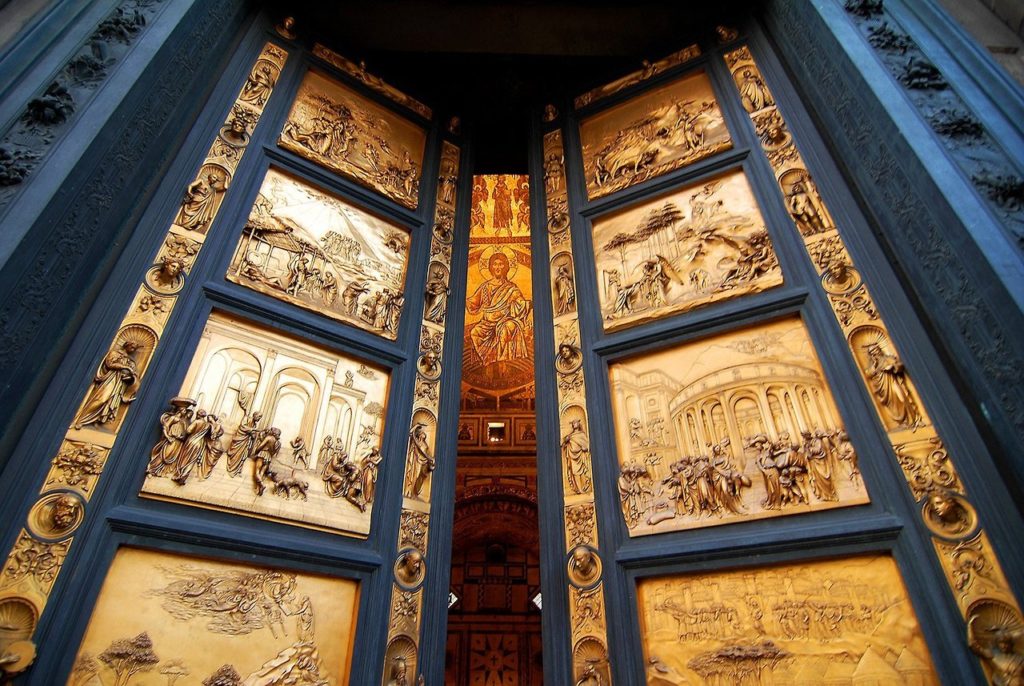
No visitor to Florence can miss the gilded bronze reliefs decorating the Porta del Paradiso (Gates of Paradise), the main gate of the Baptistery of Florence right in front of the Cathedral of Santa Maria del Fiore surmounted by Filippo Brunelleschi’s splendid cupola.

In this article, Karel Vereycken sheds new light on the contribution of Arab science and Ghiberti’s crucial role in giving birth to the Renaissance.
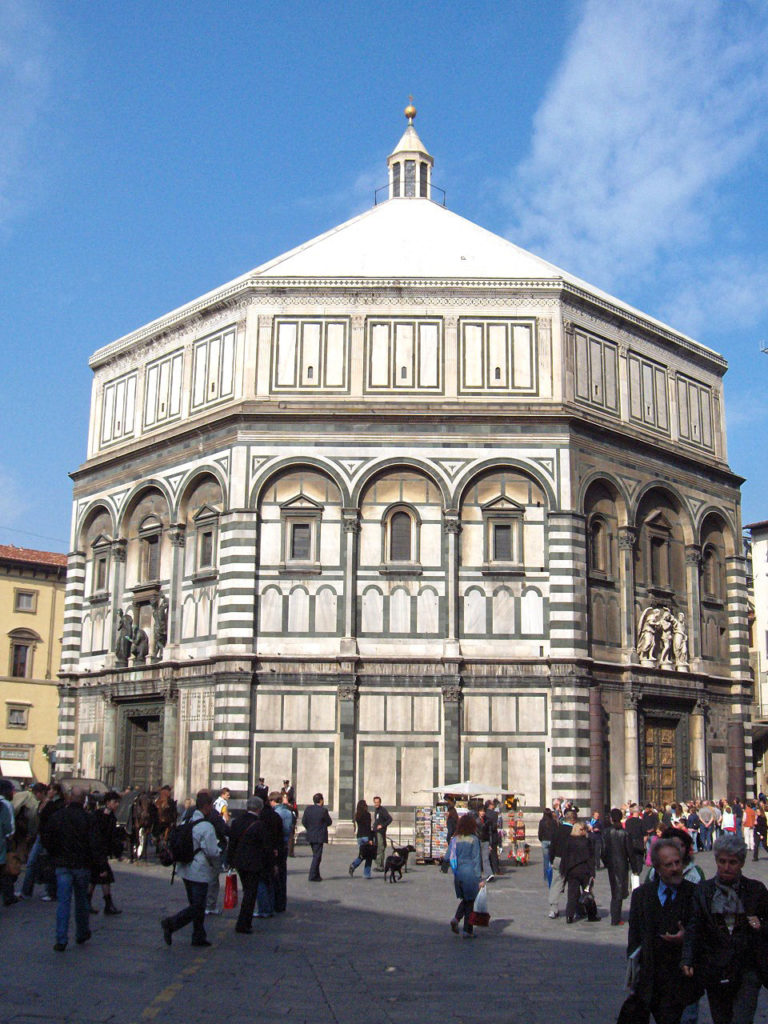
Historical context
The Baptistery, erected on what most Florentines thought to be the site of a Roman temple dedicated to the Roman God of Mars, is one of the oldest buildings in the city, constructed between 1059 and 1128 in the Florentine Romanesque style. The Italian poet Dante Alighieri and many other notable Renaissance figures, including members of the Medici family, were baptized in this baptistery.
During the Renaissance, in Florence, corporations and guilds competed for the leading role in design and construction of great projects with illustrious artistic creations.
While the Arte dei Lana (corporation of wool producers) financed the Works (Opera) of the Duomo and the construction of its cupola, the Arte dei Mercantoni di Calimala (the guild of merchants dealing in buying foreign cloth for finishing and export), took care of the Baptistery and financed the embellishment of its doors.
The Gates of Paradise
The Baptistry, an octagonal building, has four entrances (East, West, North and South) of which only three (South, North and East) have sets of artistically important bronze doors with relief sculptures. Three dates are key : 1329, 1401 and 1424.
- In 1329, the Calimala Guild, on Giotto‘s recommendation, ordered Andrea Pisano (1290-1348) to decorate a first set of doors (initialy installed as the East doors, i.e. seen when one leaves the Cathedral, but today South). These consist of 28 quatrefoil (clover-shaped) panels, with the 20 top panels depicting scenes from the life of St. John the Baptist (the patron of the edifice). The 8 lower panels depict the eight virtues of hope, faith, charity, humility, fortitude, temperance, justice, and prudence, praised by Plato in his Republic and represented during the XVIth century by the Flemish humanist painter and reader of Petrarch, Peter Brueghel the Elder. Construction took 8 years, from 1330 till 1338.

- In 1401, after having narrowly won the competition with Brunelleschi, the 23 year old and inexperienced young goldsmith Lorenzo Ghiberti (1378-1455), is commissioned by the Calima Guild to decorate the doors which are today the North Gate. Ghiberti cast the bronze high reliefs using a method known as lost-wax casting, a technique that he had to reinvent entirely since it was lost since the fall of the Roman Empire. One of the reasons Ghiberti won the contest, was that his technique was so advanced that it required 20 % less (7 kg per panel) bronze than that of his competitors, bronze being a dense material far more costly than marble. His technique, applied to the entire decoration of the North Gate, as compared to his competitors, would save some estimated 100 kg of bronze. And since in 1401, with the plague regularly hitting Florence, economic conditions were poor, even the wealthy Calimala took into account the total costs of the program.
The bronze doors are comprised of 28 panels, with 20 panels depicting the life of Christ from the New Testament. The 8 lower panels show the four Evangelists and the Church Fathers Saint Ambrose, Saint Jerome, Saint Gregory, and Saint Augustine. The construction took 24 years.

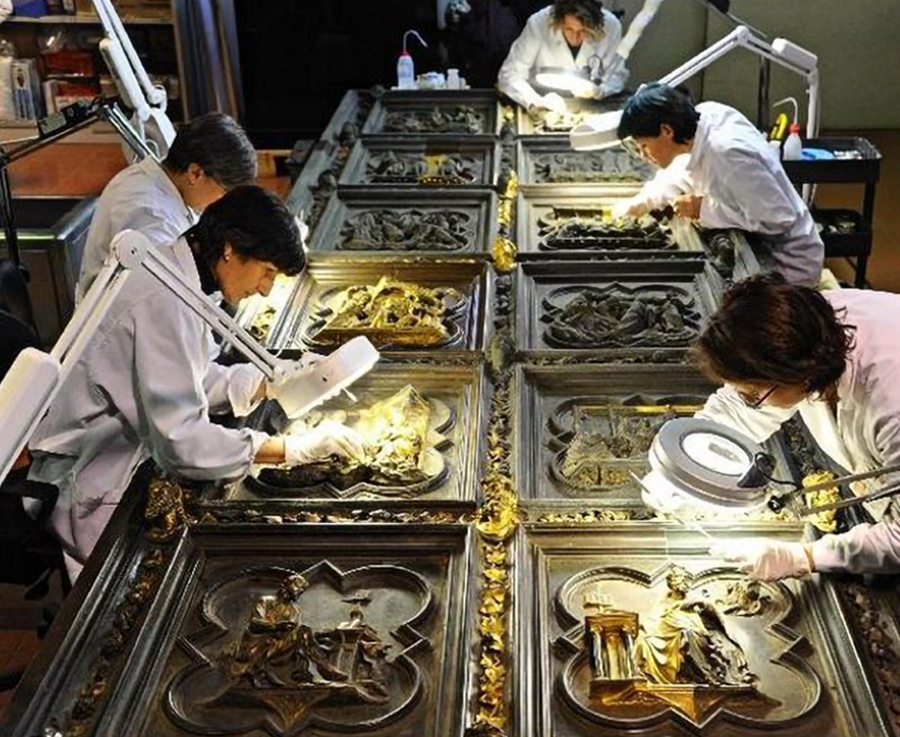
- In 1424, Ghiberti, at age 46, was given—unusually, with no competition—the task of also creating the East Gate. Only in 1452 did Ghiberti, then seventy-four years old, install the last bronze panels, since construction lasted this time 27 years! According to Giorgio Vasari (1511-1574), Michelangelo Buonarroti (1475-1564) later judged them « so beautiful they would grace the entrance to Paradise ».

Over two generations, a bevy of well paid assistants and pupils were trained by Ghiberti, including exceptional artists, such as Luca della Robbia, Donatello, Michelozzo, Benozzo Gozzoli, Bernardo Cennini, Paolo Uccello, Andrea del Verrocchio and Ghiberti’s sons, Vittore and Tommaso. And over time, the seventeen-foot-tall, three-ton bronze doors became an icon of the Renaissance, one of the most famous works of art in the world.
In 1880, the French sculptor Auguste Rodin was inspired by it for his own Gates of Hell on which he worked for 38 year
Revolution

Of utmost interest for our discussion here is the dramatic shift in conception and design of the bronze relief sculptures that occurred between the North and the East Gates, because it reflects how bot the artist as well as his patrons used the occasion to share with the broader public their newest ideas, inventions and exciting discoveries.
The themes of the North Gate of 1401 were inspired by scenes from the New Testament, except for the panel made by Ghiberti, « The Sacrifice of Isaac », which had won him the selection competition the same year. To complete the ensemble, it was therefore only logical that the East Gate of 1424 would take up the themes of the Old Testament.
Originally, it was the scholar and former chancellor of Florence Leonardo Bruni (1369-1444) who planned an iconography quite similar to the two previous doors. But, after heated discussions, his proposal was rejected for something radically new. Instead of realizing 28 panels, it was decided, for aesthetic reasons, to reduce the number of panels to only 10 much larger square reliefs, between borders containing statuettes in niches and medallions with busts.
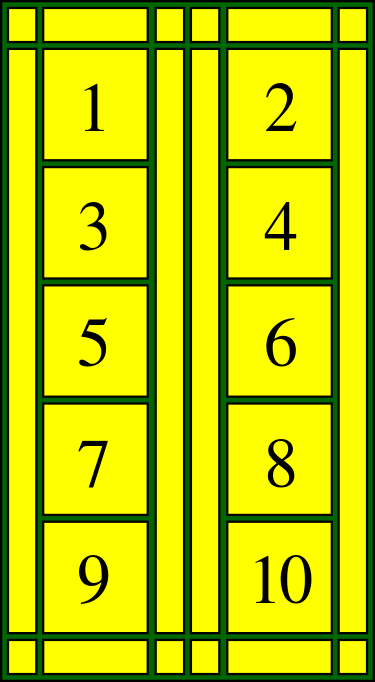
Hence, since each of the 10 chapters of the Old Testament contains several events, the total number of scenes illustrated, within the 10 panels has risen to 37 and all appear in perspective :
- Adam and Eve (The Creation of Man)
- Cain and Abel (Jalousie is the origin of Sin)
- Noah (God’s punishment)
- Abraham and Isaac (God is just)
- Jacob and Esau
- Joseph
- Moses
- Joshua
- David (Good commandor)
- Solomon and the Queen of Sheba
The general theme is that of salvation based on Latin and Greek patristic tradition. Very shocking for the time, Ghiberti places in the center of the first panel the creation of Eve, that of Adam appearing at the bottom left.
After the first three panels, focusing on the theme of sin, Ghiberti began to highlight more clearly the role of God the Savior and the foreshadowing of Christ’s coming. Subsequent panels are easier to understand. One example is the panel with Isaac, Jacob and Esau where the figures are merged with the surrounding landscape so that the eye is led toward the main scene represented in the top right.
Many of the sources for these scenes were written in ancient Greek, and since knowledge of Greek at that time was not so common, it appears that Ghiberti’s “theological advisor” was Ambrogio Traversari (1386-1439), with whom he had many exchanges.
Traversari was a close friend of Nicolas of Cusa (1401-1464), a protector of Piero della Francesca (1412-1492) and a key organizer of the Ecumenical Council of Florence of 1438-1439, which attempted to put an end to the schism separating the Church of the East from that of the West.
Perspective
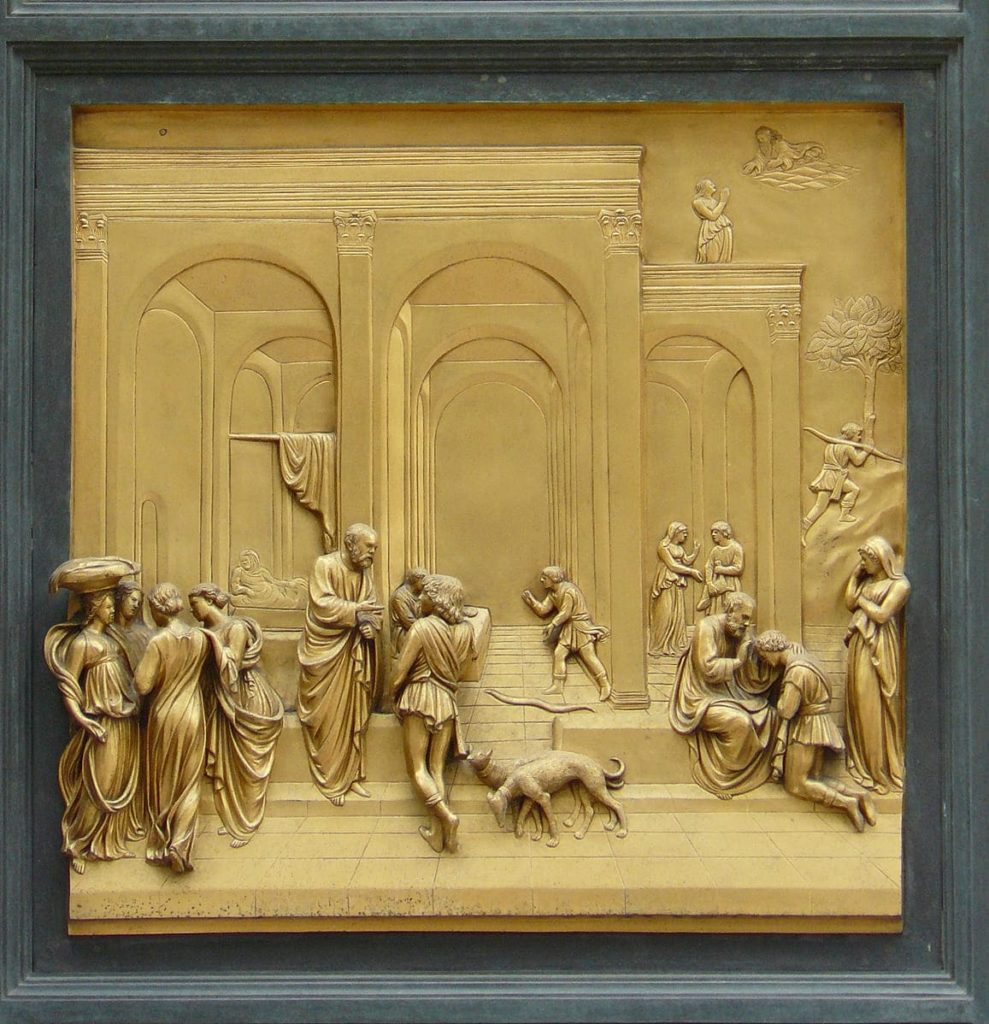
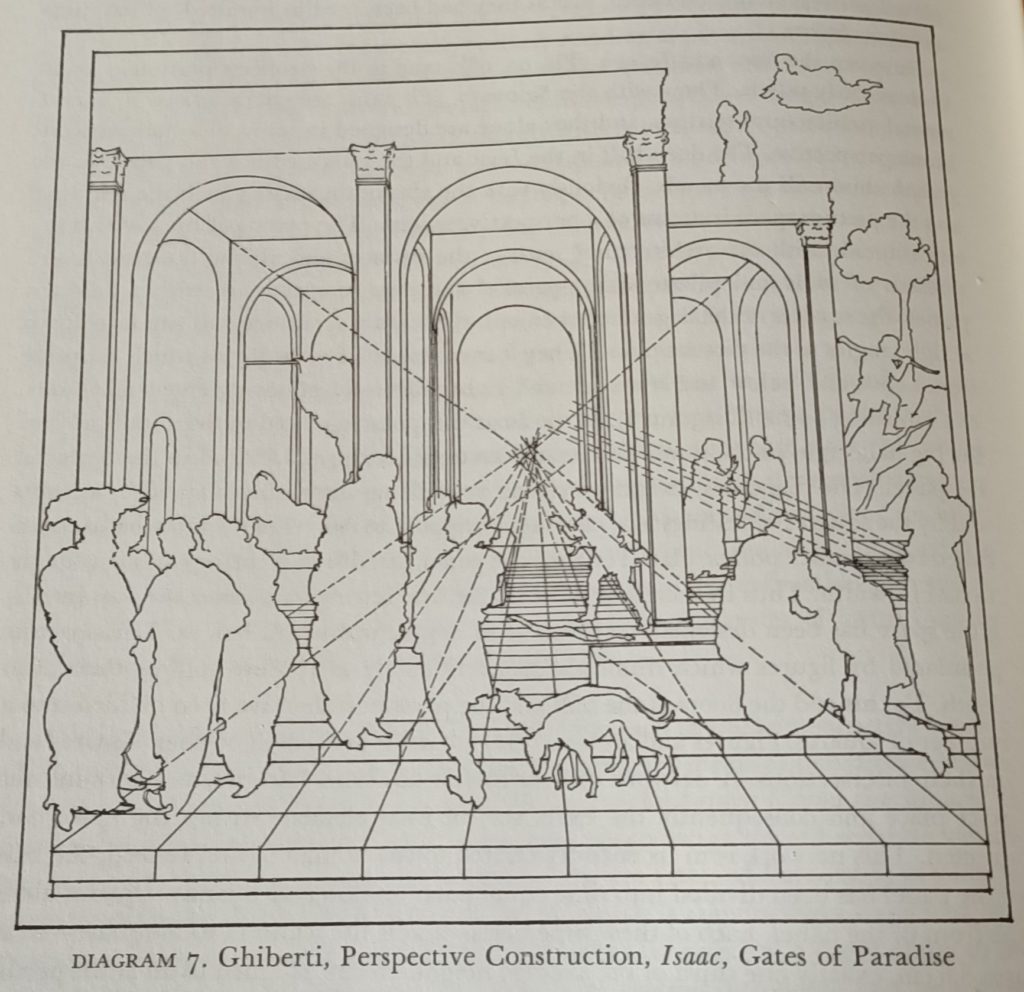
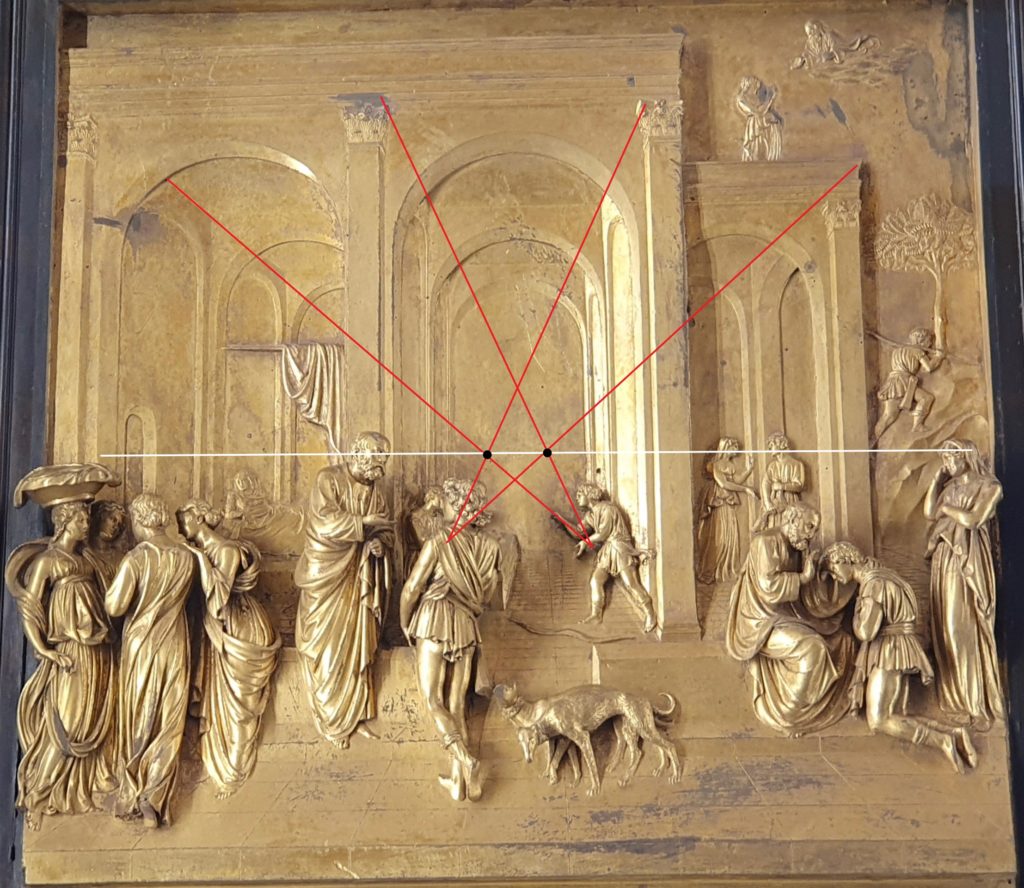
The bronze reliefs, known for their vivid illusion of deep space in relief, are one of the revolutionary events that epitomize the Renaissance. In the foreground are figures in high relief, which gradually become less protruding thereby exploiting the full illusionistic potential of the stiacciato technique later brought to its high point by Donatello. Using this form of “inbetweenness”, they integrate in one single image, what appears both as a painting, a low relief as well as a high relief. Or maybe one has to look at it another way: these are flat images traveling gradually from a surface into the full three dimensions of life, just as Ghiberti, in one of the first self-portraits of art history, reaches his head out of a bronze medal to look down on the viewers. The artist desired much more than perspective, he wanted breathing space!
This new approach will influence Leonardo Da Vinci (1452-1517). As art historian Daniel Arasse points out :
(…) It was in connection with the practice of Florentine bas-relief, that of Ghiberti at the Gate of Paradise (…) that Leonardo invented his way of painting. As Manuscript G (folio 23b) would much later state, ‘the field on which an object is painted is a capital thing in painting. (…) The painter’s aim is to make his figures appear to stand out from the field’ – and not, one might add, to base his art on the alleged transparency of that same field. It is by the science of shadow and light that the painter can obtain an effect of emergence from the field, an effect of relief, and not by that of the linear perspective.
Donatello
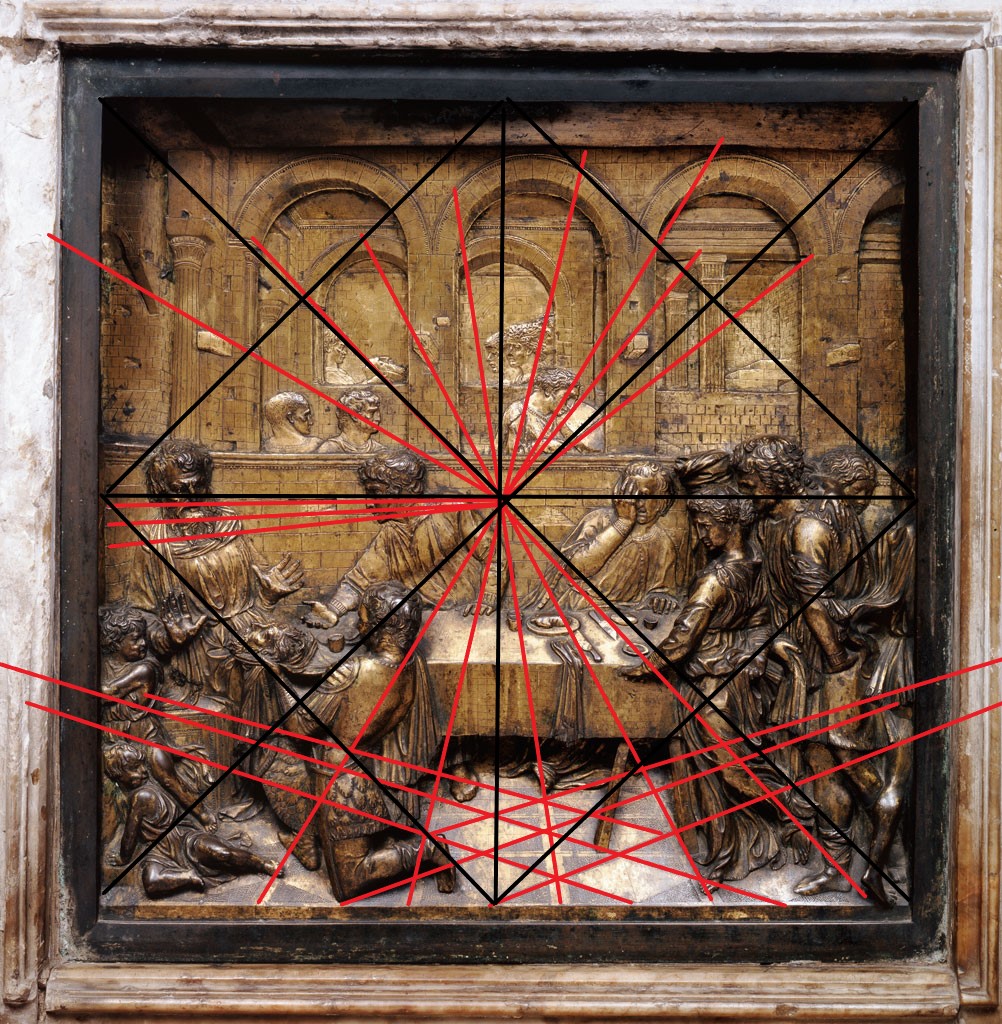
At the beginning of the 15th century, several theoretical approaches existed and eventuall contradicted each other. Around 1423-1427, the talentful sculptor Donatello, a young collaborator of Ghiberti, created his Herod’s Banquet, a bas-relief in the stiacciato technique for the baptismal font of the Siena Baptistery.
In this work, the sculptor deploys a harmonious perspective with a single central vanishing point. Around the same time, in Florence, the painter Massacchio (1401-1428) used a similar construction in his fresco The Trinity.
As we will see, Ghiberti, starting from the anatomy of the eye, opposed such an abstract approach in his works as well as in his writings and explored, as early as 1401, other geometrical models, called « binocular ». (see below).
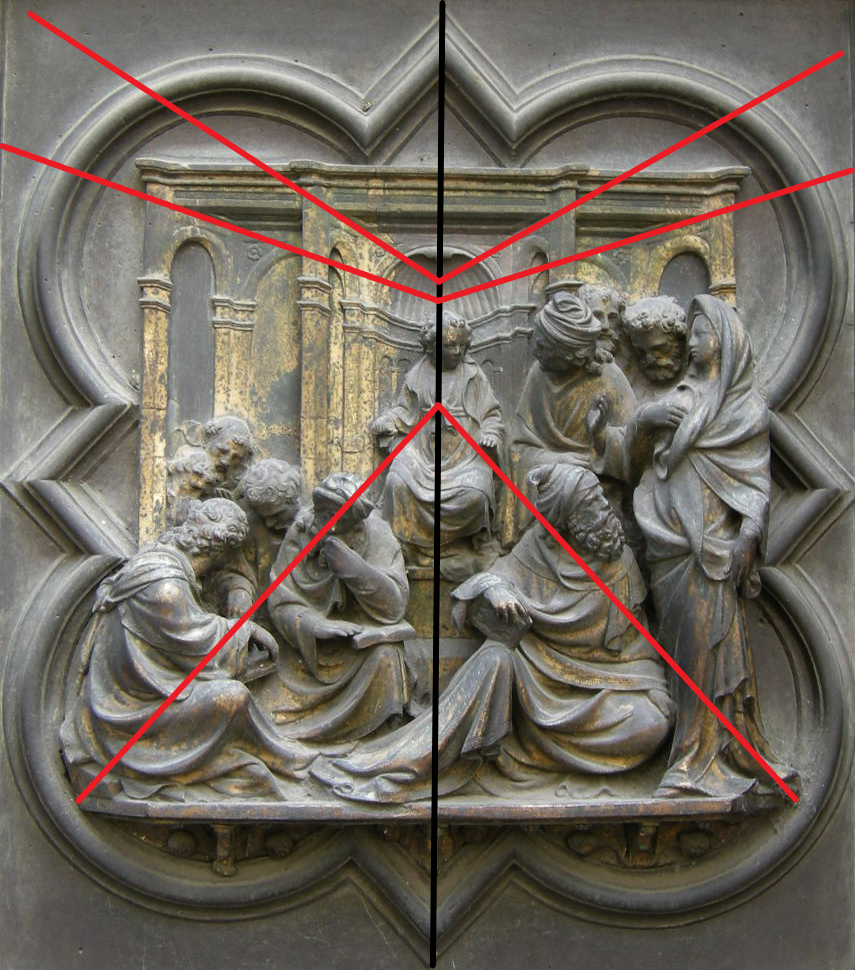
Christ among the Doctors, Ghiberti, before 1424.

Christ among the Doctors, Ghiberti, before 1424.
Then, as far as our knowledge reaches, in 1407, Brunelleschi had conducted several experiments on this question, most likely based on the ideas presented by another friend of Cusa, the Italian astronomer Paolo dal Pozzo Toscanelli (1397-1482), in the latter’s now lost treaty Della Prospettiva. What we do know is that Brunelleschi sought above all to demonstrate that all perspective is an optical illusion.
Finally, it was in 1435, that the humanist architect Leon Baptista Alberti (1406-1472), in his treatise Della Pictura, attempted, on the basis of Donatello’s approach, to theorize single vanishing point perspective as a representation of a harmonious and unified three-dimensional space on a flat surface. Noteworthy but frustrating for us today is the fact that Alberti’s treatise doesn’t contain any illustrations.
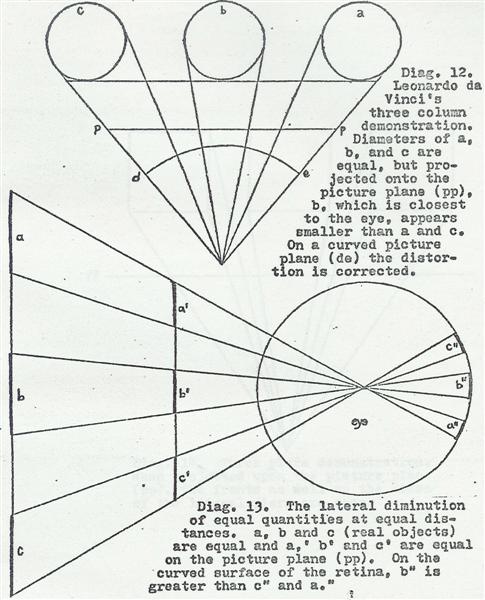
However, Leonardo, who read and studied Ghiberti’s writings on, would use the latter’s arguments to indicate the limits and even demonstrate the dysfunctionality of Alberti’s “perfect” perspective construction especially when one goes beyond a 30 degres angle.
In the Codex Madrid, II, 15 v. da Vinci realizes that « as such, the perspective offered by a rectilinear wall is false unless it is corrected (…) ».
Perspectiva artificialis versus perspectiva naturalis
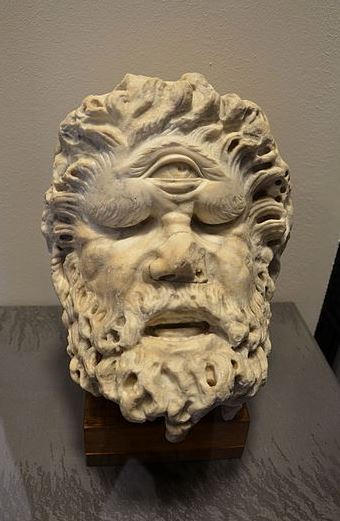
Alberti’s “perspectiva artificialis” is nothing but an abstraction, necessary and useful to represent a rational organization of space. Without this abstraction, it is fairly impossible to define with mathematical precision the relationships between the appearance of objects and the receding of their various proportions on a flat screen: width, height and depth.
From the moment that a given image on a flat screen was thought about as the intersection of a plane cutting a cone or pyramid, a method emerged for what was mistakenly considered as an “objective” representation of “real” three dimensional space, though it is nothing but an “anamorphosis”, i.e. a tromp-l’oeil or visual illusion.
What has to be underscored, is that this construction does away with the physical reality of human existence since it is based on an abstract construct pretending:
- that man is a single eyed cyclops;
- that vision emanates from one single point, the apex of the visual pyramid;
- that the eye is immobile;
- that the image is projected on a flat screen rather than on a curved retina.
Slanders and gossip
The crucial role of Ghiberti, an artist which “Ghiberti expert” Richard Krautheimer mistakenly presents as a follower of Alberti’s perspectiva artificialis, has been either ignored or downplayed.
Ghiberti’s unique manuscript, the three volumes of the Commentarii, which include his autobiography and which established him as the first modern historian of the fine arts, is not even fully translated into English or French and was only published in Italian in 1998.
Today, because of his attention to minute detail and figures « sculpted » with wavy and elegant lines, as well as the variety of plants and animals depicted, Ghiberti is generally presented as “Gothic-minded”, and therefore “not really” a Renaissance artist!
Giorgio Vasari, often acting as the paid PR man of the Medici clan, slanders Ghiberti by saying he wrote « a work in the vernacular in which he treated many different topics but arranged them in such a fashion that little can be gained from reading it. »
Admittedly, tension among humanists, was not uncommon. Self-educated craftsmen, such as Ghiberti and Brunelleschi on the one side, and heirs of wealthy wool merchants, such as Niccoli on the other side, came from entirely different worlds. For example, according to a story told by Guarino Veronese in 1413, Niccoli greeted Filippo Brunelleschi haughtily: « O philosopher without books, » to which Filippo replied with his legendary irony: « O books without philosopher ».
For sure, the Commentarii, are not written according to the rhetorical rules of those days. Written at the end of Ghiberti’s life, they may have simply been dictated to a poorly trained clerk who made dozens of spelling errors.
The humanists
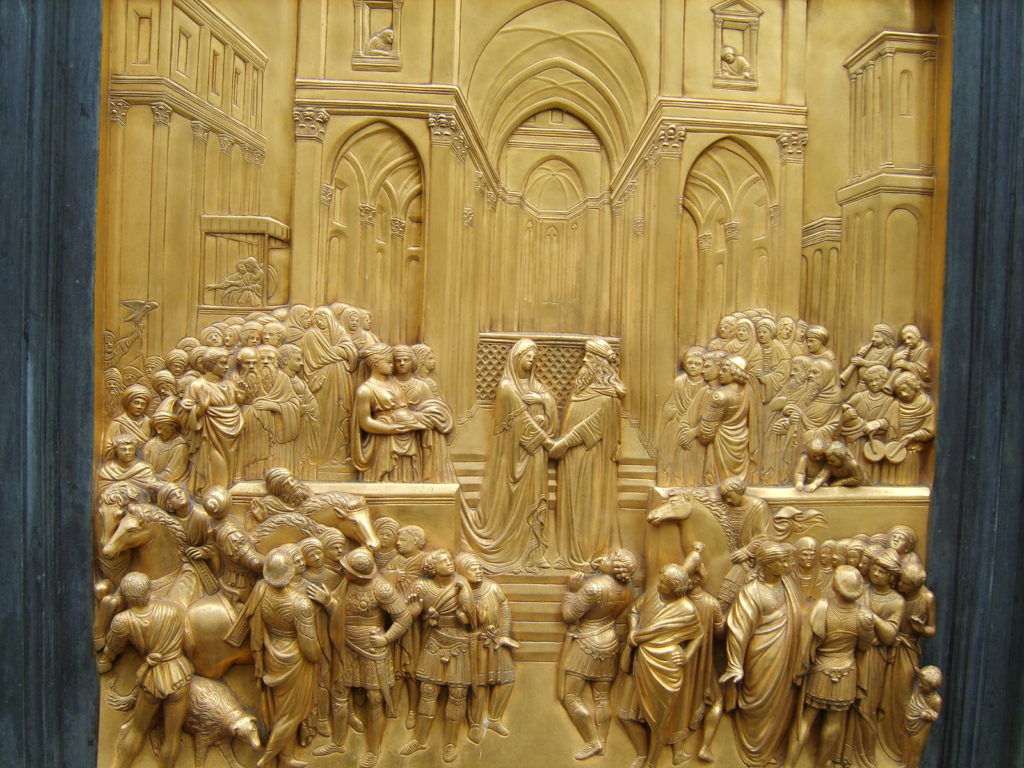
The Commentarii does reveal a highly educated author and a thinker having profound knowledge of many classical Greek and Arab thinkers. Ghiberti was not just some brilliant handcraft artisan but a typical “Renaissance man”.
In dialogue with Bruni, Traversari and the “manuscript hunter” Niccolo Niccoli, Ghiberti, who couldn’t read Greek but definitely knew Latin, was clearly familiar with the rediscovery of Greek and Arab science, a task undertaken by Boccaccio’s and Salutati’s “San Spirito Circle” whose guests (including Bruni, Traversari, Cusa, Niccoli, Cosimo di Medici, etc.) later would convene every week at the Santa Maria degli Angeli convent. Ghiberti exchanges moreover with Giovanni Aurispa, a collaborator of Traversari who brought back from Byzantium, years before Bessarion, the whole of Plato’s works to the West.
Amy R. Bloch, in her well researched study Lorenzo Ghiberti’s Gates of Paradise, Humanism, History, and Artistic Philosophy in the Italian Renaissance (2016), writes that « Traverari and Niccoli can be tied directly to the origins of the project for the Gates and were clearly interested in sculptural commissions being planned for the Baptistery. On June 21, 1424, after the Calima requested from Bruni his program for the doors, Traversari wrote to Niccoli acknowledging, in only general terms, Niccoli’s ideas for the stories to be included and mentioning, without evident disapproval, that the guild had instead turned to Bruni for advice. »
Palla Strozzi
Ghiberti’s patron, sometimes advisor, and close associate was Palla Strozzi (1372-1462), who, besides being the the richest man in Florence with a gross taxable assets of 162,925 florins in 1427, including 54 farms, 30 houses, a banking firm with a capital of 45,000 florins, and communal bonds, was also a politician, a writer, a philosopher and a philologist whose library contained close to 370 volumes in 1462.
Just as Traversari and Bruni, Strozzi learned Latin and studied Greek under the direction of the Byzantine scholar Manuel Chrysoloras, invited to Florence by Salutati.
Ghiberti’s close relationship with Strozzi, writes Bloch, « gave him access to his manuscripts and, as importantly, to Strozzi’s knowledge of them. »
But there was more. « The relationship between Ghiberti and Palla Strozzi was so close that, when Palla went to Venice in 1424 as one of two Florentine ambassadors charged with negociating an alliance with the Venetians, Ghiberti accompanied him in his retinue. »
Strozzi was known as a real humanist, always looking to preserve peace while strongly opposing oligarchical rule, both in Florence as in Venice.
In fact it was Palla Strozzi, not Cosimo de’ Medici, who first set in motion plans for the first public library in Florence, and he intended for the sacristy of Santa Trinita to serve as its entryway. While Palla’s library was never realized due to the dramatic political conflict knows as the Albizzi Coup that led to his exile in 1434, Cosimo who got a free hand to rule over Florence, would make the library project his own.
A bold statement
Ghiberti begins the Commentarii with a bold and daring statement for a Christian man in a Christian world, about how the art of antiquity came to be lost:
The Christian faith was victorious in the time of Emperor Constantine and Pope Sylvester. Idolatry was persecuted to such an extent that all the statues and pictures of such nobility, antiquity an perfection were destroyed and broken in to pieces. And with the statues and pictures, the theoretical writings, the commentaries, the drawing and the rules for teaching such eminent and noble arts were destroyed.

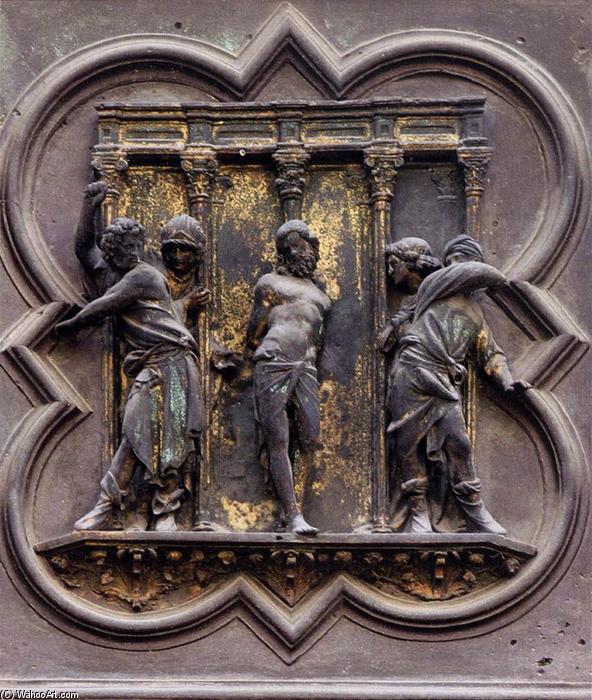
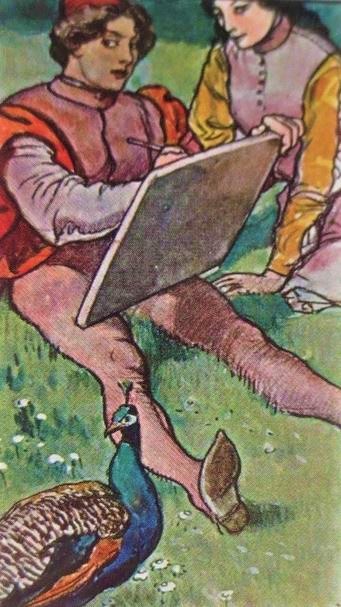
Ghiberti understood the importance of multidisciplinarity for artists. According to him, “sculpture and painting are sciences of several disciplines nourished by different teachings”.
In book I of his Commentarii, Ghiberti gives a list of the 10 liberal arts that the sculptor and the painter should master : philosophy, history, grammar, arithmic, astronomy, geometry, perspective, theory of drawing, anatomy and medecine and underlines that the necessity for an artist to assist at anatomical dissections.
As Amy Bloch underscores, while working on the Gates, in the intense process of visualizing the stories of God’s formation of the world and its living inhabitants, Ghiberti’s engagement « stimulated in him an interest in exploring all types of creativity — not only that of God, but also that of nature and of humans — and led him to present in the opening panel of the Gates of Paradise (The creation of Adam and Eve) a grand vision of the emergence of divine, natural, and artistic creation. »

The inclusion of details evoking God’s craftmanship, says Bloch, « recalls similes that liken God, as the maker of the world, to an architect, or, in his role as creator of Adam, to a sculptor or painter. Teh comparison, which ultimately derives from the architect-demiurge who creates the world in Plato’s Timaeus, appears commonly in medieval Jewish and Christian exegesis. »
Philo of Alexandria wrote that man was modeled « as by a potter » and Ambrose metaphorically called God a « craftsman (artifex) and a painter (pictor) ». Consequently, if man is « the image of God » as says Augustine and the model of the « homo faber – man producer of things », then, according to Salutati, « human affairs have a similarity to divine ones ».
The power of vision and the composition of the Eye
Concerning vision, Ghiberti writes:
I, O most excellent reader, did not have to obey to money, but gave myself to the study of art, which since my childhood I have always pursued with great zeal and devotion. In order to master the basic principles I have sought to investigate the way nature functions in art; and in order that I might be able to approach her, how images come to the eye, how the power of vision functions, how visual [images] come, and in what way the theory of sculpture and painting should be established.
Now, any serious scholar, having worked through Leonardo’s Notebooks, who then reads Ghiberti’s I Commentarii, immediately realizes that most of Da Vinci’s writings were basically comments and contributions about things said or answers to issues raised by Ghiberti, especially respecting the nature of light and optics in general. Leonardo’s creative mindset was a direct outgrowth of Ghiberti’s challenging world outlook.
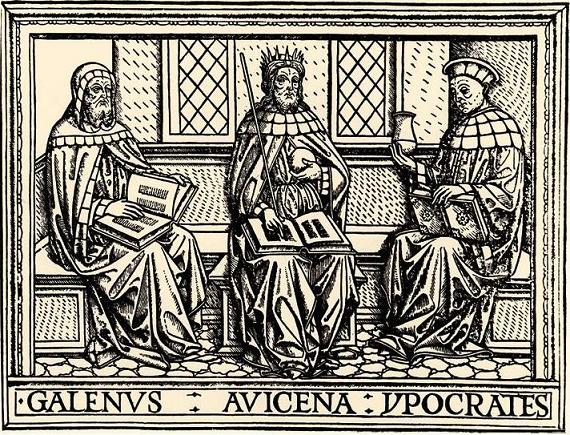
In Commentario 3, 6, which deals with optics, vision and perspective, Ghiberti, opposing those for whom vision can only be explained by a purely mathematical abstraction, writes that “In order that no doubt remains in the things that follow, it is necessary to consider the composition of the eye, because without this one cannot know anything about the way of seeing.” He then says, that those who write about perspective don’t take into account “the eye’s composition”, under the pretext that many authors would disagree.
Ghiberti regrets that despite the fact that many “natural philosophers” such as Thales, Democritus, Anaxagoras and Xenophanes have examined the subject along with others devoted to human health such as “Hippocrates, Galen and Avicenna”, there is still so much confusion.
Indeed, he says, “speaking about this matter is obscure and not understood, if one does not have recourse to the laws of nature, because more fully and more copiously they demonstrate this matter.”
Avicenna, Alhazen and Constantine


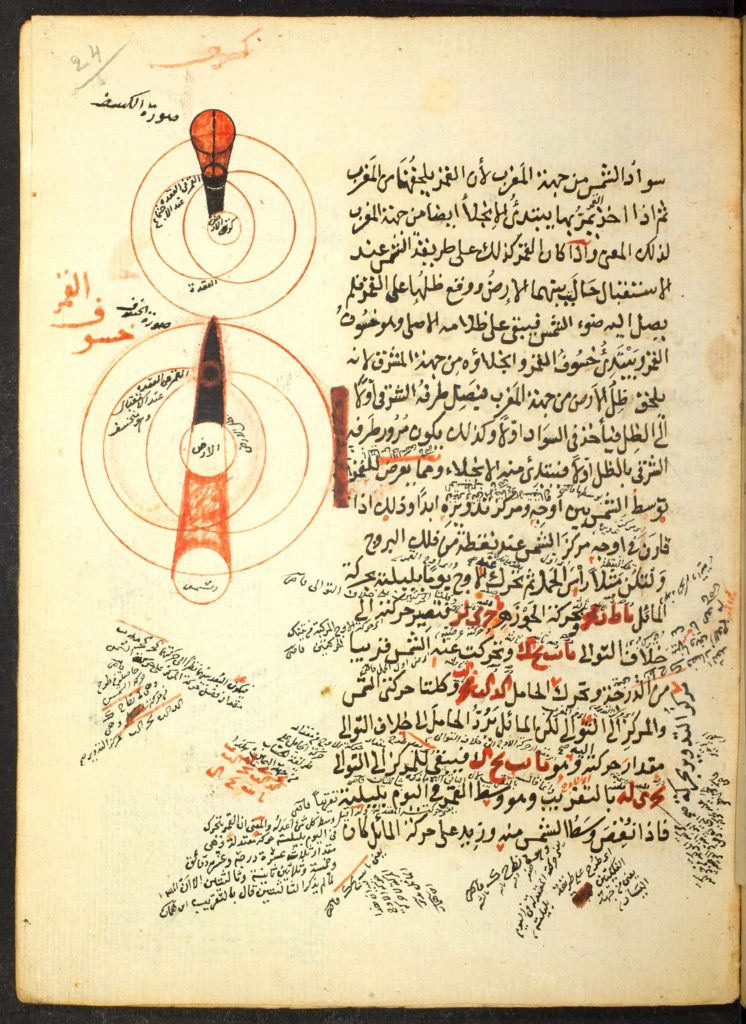
Therefore, says Ghiberti:
it is necessary to affirm some things that are not included in the perspective model, because it is very difficult to ascertain these things but I will try to clarify them. In order not to deal superficially with the principles that underlie all of this, I will deal with the composition of the eye according to the writings of three authors, Avicenna (Ibn Sina), in his books, Alhazen (Ibn al Haytham) in his first volume on perspective (Optics), and Constantine (the Latin name of the Arab scholar and physician Qusta ibn Luqa) in his ‘First book on the Eye’; for these authors suffice and deal with much certainty in these subjects that are of interest to us.
This is quite a statement! Here we have “the” leading, founding figure of the Italian and European Renaissance with its great contribution of perspective, saying that to get any idea about how vision functions, one has to study three Arab scientists: Ibn Sina, Ibn al Haytham and Qusta ibn Luqa ! Cultural Eurocentrism might be one reason why Ghiberti’s writings were kept in the dark.
Ibn al-Haytham (Alhazen) made important contributions to opthalmology and improved upon earlier conceptions of the processes involved in vision and visual perception in his Treatise on Optics (1021), which is known in Europe as the Opticae Thesaurus. Following his work on the camera oscura (darkroom) he was also the first to imagine that the retina (a curved surface), and not the pupil (a point) could be involved in the process of image formation.
Avicenna, in the Canon of Medicine (ca. 1025), describes sight and uses the word retina (from the Latin word rete meaning network) to designate the organ of vision.
Later, in his Colliget (medical encyclopedia), Ibn Rushd (Averroes, 1126-1198) was the first to attribute to the retina the properties of a photoreceptor.
Avicenna’s writings on anatomy and medical science were translated and circulating in Europe since the XIIIth century, Alhazen’s treatise on optics, which Ghiberti quotes extensively, had just been translated into Italian under the title De li Aspecti.
It is now recognized that Andrea del Verrocchio, whose best known pupil was Leonardo da Vinci (1452-1517) was himself one of Ghiberti’s pupils. Unlike Ghiberti, who mastered Latin, neither Verrocchio nor Leonardo mastered a foreign language.
What is known is that while studying Ghiberti’s Commentarii, Leonardo had access in Italian to a series of original quotations from the Roman architect Vitruvius and from Arab scientists such as Avicenna, Alhazen, Averroes and from those European scientists who studied Arab optics, notably the Oxford Fransciscans Roger Bacon (1214-1294), John Pecham (1230-1292) and the Polish monk working in Padua, Erazmus Ciolek Witelo (1230-1275), known by his Latin name Vitellion.
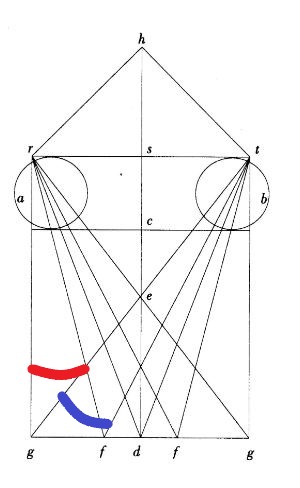
As stressed by Professor Dominque Raynaud, Vitellion introduces the principle of binocular vision for geometric considerations.
He gives a figure where we see the two eyes (a, b) receiving the images of points located at equal distance from the hd axis.
He explains that the images received by the eyes are different, since, taken from the same side, the angle grf (in red) is larger than the angle gtf (in blue). It is necessary that these two images are united at a certain point in one image (Diagram).
Where does this junction occur? Witelo says: « The two forms, which penetrate in two homologous points of the surface of the two eyes, arrive at the same point of the concavity of the common nerve, and are superimposed in this point to become one ».
The fusion of the images is thus a product of the internal mental and nervous activity.
The great astronomer Johannes Kepler (1571-1630) will use Alhazen’s and Witelo’s discoveries to develop his own contribution to optics and perspective. “Although up to now the [visual] image has been [understood as] a construct of reason,” Kepler observes in the fifth chapter of his Ad Vitellionem Paralipomena (1604), “henceforth the representations of objects should be considered as paintings that are actually projected on paper or some other screen.” Kepler was the first to observe that our retina captures an image in an inverted form before our brain turns it right side up.
Out of this Ghiberti, Uccello and also the Flemish painter Jan Van Eyck, in contact with the Italians, will construct as an alternative to one cyclopic single eye perspective revolutionary forms of “binocular” perspective while Leonardo and Louis XI’ court painter Jean Fouquet will attempt to develop curvilinear and spherical space representations.
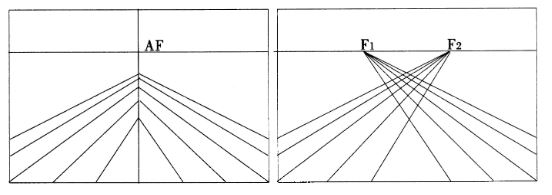
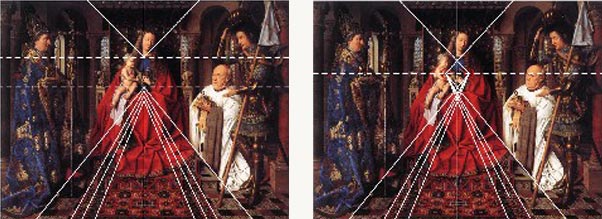


In China, eventually influenced by Arab optical science breakthrough’s, forms of non-linear perspective, that integrate the mobility of the eye, will also make their appearance during the Song Dynasty.
Light
Ghiberti will add another dimension to perspective: light. One major contribution of Alhazen was his affirmation, in his Book of Optics, that opaque objects struck with light become luminous bodies themselves and can radiate secondary light, a theory that Leonardo will exploit in his paintings, including in his portraits.
Already Ghiberti, in the way he treats the subject of Isaac, Jacob and Esau (Figure), gives us an astonishing demonstration of how one can exploit that physical principle theorized by Alhazen. The light reflected by the bronze panel, will strongly differ according to the angle of incidence of the arriving rays of light. Arriving either from the left of from the right side, in both cases, the Ghiberti’s bronze relief has been modeled in such a way that it magnificently strengthens the overall depth effect !

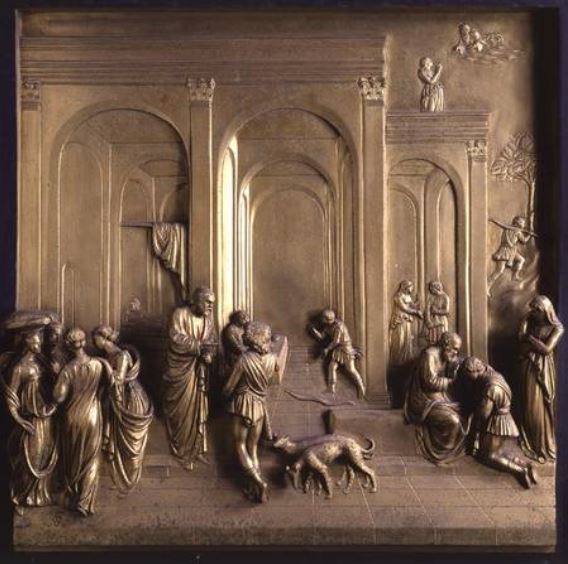
While the experts, especially the neo-Kantians such as Erwin Panofsky or Hans Belting, say that these artists were “primitives” because applying the “wrong” perspective model, they can’t grasp the fact that they were in reality exploring a far “higher domain” than the mere pure mathematical abstraction promoted by the Newton-Galileo cult that became the modern priesthood ruling over “science”.
Much more about all of this can and should be said. Today, the best way to pay off the European debt to “Arab” scientific contributions, is to reward not just the Arab world but all future generations with a better future by opening to them the “Gates of Paradise”.
See all of Ghiberti’s works at the WEB GALLERY OF ART
Short Biography
- Arasse, Daniel, Léonard de Vinci, Hazan, 2011;
- Avery, Charles, La sculpture florentine de la Renaissance, Livre de poche, 1996, Paris;
- Belting, Hans, Florence & Baghdad, Renaissance art and Arab science, Harvard University Press, 2011;
- Bloch, Amy R., Lorenzo Ghiberti’s Gates of Paradise; Humanism, History and Artistic Philosophy in the Italian Renaissance, Cambridge University Press, 2016, New York;
- Borso, Franco et Stefano, Uccello, Hazan, Paris, 2004 ;
- Butterfield, Andrew, Verrocchio, Sculptor and painter of Renaissance Florence, National Gallery, Princeton University Press, 2020 ;
- Butterfield, Andrew, Art and Innovation in Ghiberti’s Gates of Paradise, High Museum of Art, Yale University Press, 2007;
- Kepler, Johannes, Paralipomènes à Vitellion, 1604, Vrin, 1980, Paris;
- Krautheimer, Richard and Trude, Lorenzo Ghiberti, Princeton University Press, New Jersey, 1990;
- Martens, Maximiliaan, La révolution optique de Jan van Eyck, dans Van Eyck, Une révolution optique, Hannibal – MSK Gent, 2020.
- Pope-Hennessy, John, Donatello, Abbeville Press, 1993 ;
- Radke, Gary M., Lorenzo Ghiberti: Master Collaborator; The Gates of Paradise, Lorenzo Ghiberti’s Renaissance Masterpiece, High Museum of Atlanta and Yale University Press, 2007;
- Rashed, Roshi, Geometric Optics, in History of Arab Sciences, edited by Roshdi Rashed, Vol. 2, Mathematics and physics, Seuil, Paris, 1997.
- Raynaud, Dominique, L’hypothèse d’Oxford, essai sur les origines de la perspective, PUF, 1998, Paris.
- Raynaud, Dominique, Ibn al-Haytham on binocular vision: a precursor of physiological optics, Arabic Sciences and Philosophy, Cambridge University Press (CUP), 2003, 13, pp. 79-99.
- Raynaud, Dominique, Perspective curviligne et vision binoculaire. Sciences et techniques en perspective, Université de Nantes, Equipe de recherche: Sciences, Techniques, et Sociétés, 1998, 2 (1), pp.3-23.;
- Vereycken, Karel, interview with People’s Daily: Leonardo Da Vinci’s « Mona Lisa » resonates with time and space with traditional Chinese painting, 2019.
- Vereycken, Karel, Uccello, Donatello, Verrocchio and the art of military command, 2022.
- Vereycken, Karel, The Invention of Perspective, Fidelio, 1998.
- Vereycken, Karel, Van Eyck, un peintre flamand dans l’optique arabe, 1998.
- Vereycken, Karel, Mutazilism and Arab astronomy, two bright stars in our firmament, 2021.
- Walker, Paul Robert, The Feud That Sparked the Renaissance, How Brunelleschi and Ghiberti changed the World, HarperCollins, 2002.
Posted by: Karel Vereycken | on mars 13, 2022
Uccello, Donatello, Verrocchio et l’art du commandement militaire
Uccello, Donatello, Verrocchio et l’art du commandement militaire. Enquête et réflexions sur les événements clés et les réalisations artistiques qui ont fait la Renaissance. Par Karel Vereycken, Paris.
Prologue
S’il y a encore beaucoup à dire, à écrire et à apprendre sur les grands génies de la Renaissance européenne, il est temps aussi de s’intéresser à ceux que l’historien Georgio Vasari appela avec condescendance des « figures de transition ».
Comment mesurer l’apport de Pieter Bruegel l’Ancien sans connaître Pieter Coecke van Aelst ? Comment apprécier l’œuvre de Rembrandt sans connaître Pieter Lastman ? En quoi Raphaello Sanzio a-t-il innové par rapport à son maître Le Pérugin ?
En 2019, une exposition remarquable consacrée à Andrea del Verrocchio (1435-1488), à la National Gallery de Washington, a mis en lumière ses grandes réalisations, fulgurances étonnantes d’une beauté inouïe que son élève Léonard de Vinci (1452-1519) a su théoriser et mettre à profit.
Le sfumato de Léonard ? Verrocchio en est le pionnier, notamment dans ses portraits de femmes, exécutés aux traits estompés combinant le crayon, la craie et la gouache.
Une découverte
En feuilletant le catalogue de cette exposition, ma joie fut grande en découvrant (et à ma connaissance, personne avant moi ne semble l’avoir remarqué) que l’image de l’ange énigmatique qui rencontre l’œil du spectateur dans le tableau de Léonard intitulé La Vierge aux rochers (1483-1486) (Louvre, Paris), à part sa posture plus posée, n’est grosso modo qu’une « citation visuelle » d’un haut-relief en terre cuite (Louvre, Paris) réalisé, nous dit-on, par « Verrocchio et un assistant ».
L’hypothèse qu’il s’agisse de Léonard en personne est plus que tentante, étant donné sa présence comme apprenti auprès du maître !
Bien d’autres ont fait leurs débuts dans l’atelier de Verrocchio, notamment Lorenzo de Credi, Sandro Botticelli, Piero Perugino (maître de Raphaël) et Domenico Ghirlandaio (maître de Michel-Ange).
S’inscrivant dans la tradition des grands chantiers lancés à Florence par le grand mécène de la Renaissance Côme de Medicis pour la réalisation des « portes du Baptistère » et l’achèvement de la coupole de Florence par Philippo Brunelleschi (1377-1446), Verrocchio conçoit son atelier comme une véritable école « polytechnique ».
A Florence, pour les artistes, les commandes affluent. Afin de pouvoir répondre à toutes les demandes, Verrocchio, ayant lui-même reçu une formation d’orfèvre, forme ses élèves comme artisans-ingénieurs-artistes : dessin, anatomie, perspective, géologie, sculpture, travail des métaux, de la pierre et du bois, architecture, décoration intérieure, poésie, musique et enfin, peinture. Un niveau de liberté et une exigence de créativité malheureusement disparus depuis longtemps.
En peinture, Verrocchio aurait fait ses débuts chez le peintre Fra Filippo Lippi (1406-1469). Quant au métier de fondeur de bronze, il aurait été, comme Donatello, Masolino, Michelozzo, Uccello et Pollaiuolo, l’un des apprentis recrutés par Lorenzo Ghiberti (1378-1455) dont l’atelier, à partir de 1401 et pendant plus de quarante ans, est chargé de concevoir et de réaliser les bas-reliefs en bronze de deux des immenses portes du Baptistère de Florence.
D’autres suggèrent que Verrocchio aurait été formé par Michelozzo, l’ancien compagnon de Ghiberti devenu par la suite l’associé en affaires de Donatello. Adolescent, ce dernier avait accompagné Brunelleschi lorsqu’il se rendait à Rome pour y étudier l’héritage de l’art grec et romain, et pas seulement au niveau architectural.
L’héritage humaniste de Ghiberti
En réalité, Verrocchio n’a fait que faire sienne l’approche de l’atelier « polytechnique » de Ghiberti, avec qui il avait appris le métier.
Excellent artisan qu’on accuse à tort d’être resté accroché au « style gothique », lui aussi est orfèvre, collectionneur d’art, musicien, lettré humaniste et historien.
Son génie, c’est d’avoir compris l’importance de la pluridisciplinarité pour les artistes. Selon lui « la sculpture et la peinture sont des sciences de plusieurs disciplines agrémentées de différents enseignements. »
Les dix disciplines qu’il juge important pour former les artistes sont la grammaire, la philosophie, l’histoire. Suivent ensuite la perspective, la géométrie, le dessin, l’astronomie, l’arithmétique, la médecine et l’anatomie.
On ne peut découvrir, pense Ghiberti, que lorsqu’on est parvenu à isoler l’objet de sa recherche de facteurs interférant, et on ne peut trouver qu’en se détachant d’un système dogmatique ;
Anticipant le type de biomimétisme qui va caractériser Léonard par la suite, Ghiberti affirme qu’il a cherché
Ghiberti, qui fréquente le cercle des humanistes animé par Ambrogio Traversari, a le souci de s’appuyer sur l’autorité des textes anciens, en particulier arabes :
Bien que volontairement ignoré et calomnié par Vasari, le livre des Commentaires de Ghiberti constitue un véritable manuel pour les artistes, écrit par un artiste. C’est d’ailleurs en lisant ce manuscrit que Léonard de Vinci se familiarise avec d’importantes contributions arabes à la science, en particulier l’œuvre remarquable d’Alhazen, dont le traité d’optique venait d’être traduit du latin en italien sous le titre De li Aspecti, œuvre longuement citée par Ghiberti dans son Commentario terzo. Saint Jean-Baptiste, bronze réalisé par Ghiberti, Orsanmichele, Florence.
Dans ce manuscrit, les apports de Ghiberti sont modestes. Cependant, pour les élèves de son élève Verrocchio, comme Léonard, qui ne maîtrisaient aucune langue étrangère, le livre de Ghiberti mettait à leur disposition en italien une série de citations originales de l’architecte romain Vitruve, de scientifiques et de polymathes arabes comme Alhazen, Avicenne, Averroès et de scientifiques européens ayant étudié l’optique arabe, tels que les franciscains d’Oxford Roger Bacon et John Pecham ou encore le moine polonais Witelo (Vitellion) à Padou.
Ce qui fait dire à l’historien A. Mark Smith que, par l’intermédiaire de Ghiberti, le Livre d’optique d’Alhazen
Enfin, en 1412, tout en coordonnant les travaux de la porte du Baptistère, Ghiberti est aussi, avec son Saint Jean-Baptiste, le premier sculpteur de la Renaissance à couler une statue en bronze d’une hauteur de 255 cm pour décorer Orsanmichele, la maison des Corporations à Florence.
La fonte « à la cire perdue »
Pour réaliser des bronzes d’une telle taille, vu le prix du métal, les artistes font appel à la technique dite de « fonte à la cire perdue ».
Elle consiste à confectionner d’abord un modèle en terre réfractaire (A), recouvert d’une épaisseur de cire correspondant à l’épaisseur de bronze recherchée (B). Ce modèle est ensuite recouvert d’une épaisse couche de plâtre qui, en se solidifiant, forme un moule extérieur. En pénétrant dans ce moule par des tiges prévues à cet effet (J), le bronze en fusion va se substituer à la cire. Enfin, une fois le métal solidifié, on brise le revêtement (K). Reste alors à affûter les détails et polir l’ensemble selon le choix de l’artiste (L).
Cette technique s’avérera par la suite fort utile pour fabriquer des canons et des cloches. Si elle semble avoir été parfaitement maîtrisée en Afrique, notamment à Ifé dès le XIIe siècle, en Europe, ce n’est qu’à la Renaissance, avec les commandes reçues par Ghiberti et Donatello, qu’elle sera entièrement réinventée.
En 1466, à la mort de Donatello, c’est Verrocchio qui devient à son tour le sculpteur en titre des Médicis pour lesquels il réalise une série d’œuvres, notamment, après Donatello, son propre David en bronze (musée national du Bargello, Florence).
Si, avec cette promotion, son ascendance sociale est certaine, Verrocchio se trouve devant le plus grand défi qu’un artiste de la Renaissance ait pu imaginer : comment égaler, voire dépasser Donatello, un artiste dont on n’a jamais assez loué le génie ?
L’art équestre
Le décor ainsi planté, abordons maintenant le sujet de l’art du commandement militaire en comparant quatre monuments équestres :
A) l’empereur romain Marc-Aurèle, sur la place du Capitole à Rome (175 après J.-C.) ;
B) la fresque de John Hawkwood par Paolo Uccello, dans l’église de Santa Maria del Fiore à Florence (1436) ;
C) Erasmo da Narni, dit « Gattamelata » (1446-1450), réalisé par Donatello à Padoue ;
D) Bartolomeo Colleoni par Andrea del Verrocchio à Venise (1480-1488).
Les statues équestres sont apparues en Grèce au milieu du VIe siècle avant J.-C. pour honorer les cavaliers victorieux d’une course. À partir de l’époque hellénistique, elles sont réservées aux plus hauts personnages de l’État, souverains, généraux victorieux et magistrats. À Rome, sur le forum, elles constituaient un honneur suprême, soumis à l’approbation du Sénat. Réalisées en bronze, ces statues équestres se dressent le plus souvent à l’endroit où les troupes ont combattu. Si chaque statue rappelle l’importance du commandement militaire et politique, la manière d’exercer cette responsabilité est bien différente.
A. Marc Aurèle à Rome
Marc Aurèle est né à Rome en 121 après J.-C., dans une famille noble d’origine espagnole. A la mort de son père, son oncle l’empereur Hadrien confie l’enfant à son successeur Antonin. Ce dernier l’adopte et lui donne une excellente éducation. Il est initié très tôt à la philosophie par son maître Diognetus. Intéressé par les stoïciens, il adopte un temps leur mode de vie, dormant à même le sol, portant une tunique rêche, avant d’en être dissuadé par sa mère.
En 175, il se rend à Athènes où il se met à encourager la philosophie. Il aide financièrement les philosophes et les rhétoriciens en leur accordant un salaire fixe. Partisan du pluralisme, il soutient l’Académie platonicienne, le Lycée d’Aristote, le Jardin d’Épicure et le Portique stoïcien.
En revanche, sous son règne, les persécutions contre les chrétiens sont nombreuses. Il les considère comme des fauteurs de troubles, du fait qu’ils refusent de reconnaître les dieux romains, et comme des fanatiques.
Érigée en 175 après J.-C., la statue était entièrement dorée. Si on ignore son emplacement dans l’Antiquité, au Moyen Âge, elle se trouvait devant la basilique Saint-Jean-de-Latran, érigée par Constantin, et le palais du Latran, alors résidence papale. En 1538, le pape Paul III fait transférer le monument de Marc Aurèle au Capitole, siège du gouvernement de la ville. Michel-Ange restaure la statue et redessine la place qui l’entoure.
C’est sans doute la statue équestre la plus célèbre, et surtout la seule datant de la Rome antique qui ait survécu, les autres ayant été fondues pour fabriquer des pièces de monnaie ou des armes… Si la statue a survécu, c’est grâce à un malentendu : on pensait qu’elle représentait Constantin, le premier empereur romain à s’être converti au christianisme au début du IVe siècle, et il était hors de question de détruire l’image d’un souverain chrétien.
Mais la présence d’un ennemi vaincu sous la jambe avant droite du cheval (présence attestée par des témoignages médiévaux, et disparue depuis), le geste de l’empereur et la forme du tapis de selle, inhabituelle dans le monde romain, suggèrent que la statue commémorait les victoires de Marc Aurèle, peut-être à l’occasion de son triomphe à Rome en 176, ou même après sa mort. En effet, son règne (161-180) a été marqué par des guerres incessantes pour contrer les incursions de peuples germaniques ou orientaux aux frontières d’un Empire désormais menacé et sur la défensive.
Le cheval, qui n’est pas très grand mais semble puissant, a été sculpté très soigneusement et avec réalisme. Ses naseaux sont fortement dilatés, ses lèvres tirées par le mors laissent apparaître ses dents et sa langue. La jambe levée, il vient d’être arrêté par son cavalier, qui tient les rênes de la main gauche. Comme lui, le cheval tourne légèrement la tête vers la droite, signe que la statue a été conçue pour être vue de ce côté. Une partie de son harnais est conservée, mais les rênes ont disparu.
L’athlétique cavalier domine néanmoins par sa taille celle de ce puissant cheval, qu’il monte sans étriers (accessoires inconnus des Romains). Il est vêtu d’une tunique courte ceinturée à la taille et d’un manteau d’apparat agrafé sur l’épaule droite. Il s’agit d’un vêtement civil et non militaire, adapté à un contexte pacifique. Il porte des chaussures en cuir maintenues par des lanières entrelacées.
La statue frappe par sa taille (424 cm de haut incluant le socle) et la majesté qu’elle dégage. Sans armure ni arme, les yeux grands ouverts et sans émotion, l’empereur lève le bras droit. Son autorité découle avant tout de la fonction qu’il incarne : il est l’Empereur qui protège son Empire et son peuple en punissant ses ennemis sans pitié.
B. La fresque de Paolo Uccello à Florence
En 1436, à la demande de Côme de Médicis, Paolo Uccello (1397-1475) est chargé de réaliser une fresque (732 × 404 cm) représentant John Hawkwood (1323-1394), fils d’un tanneur anglais devenu chef de guerre pendant la guerre de Cent Ans en France et dont le nom sera italianisé en Giovanno Acuto. Au service du plus offrant, notamment de villes italiennes rivales, la compagnie de mercenaires de Hawkwood, sanguinaires, inspire la terreur car elle ne fait pas de quartiers.
A Florence, même si cela peut paraître paradoxal, c’est le chancelier humaniste Coluccio Salutati (1331-1406) qui met Hawkwood à la tête d’une armée régulière au service de la Signoria.
Cette démarche n’est pas sans rappeler celle du roi Louis XI qui, pour contrôler les écorcheurs et autres égorgeurs qui ravageaient alors la France, parvint à les discipliner en les incorporant dans une armée permanente, la nouvelle armée royale.
Les humanistes de la Renaissance, notamment Leonardo Bruni (1370-1440) dans son De Militia (1420), sont conscients du fléau que représente l’utilisation de mercenaires dans les conflits. Seule une armée permanente, pensent-ils, formée de professionnels et mieux encore, de citoyens, et entretenue par un Etat ou une ville, peut garantir une paix durable.
Bien que Hawkwood ait fidèlement protégé la ville pendant 18 ans, son « professionnalisme » de mercenaire était loin de faire l’unanimité, au point d’inspirer le proverbe « Inglese italianato è un diavolo Incarnato » (« Un Anglais italianisé est un diable incarné »). Pétrarque le dénonce, Boccace tente en vain de monter une offensive diplomatique contre lui, sainte Catherine de Sienne le supplie de quitter l’Italie, Chaucer le rencontre et, sans doute, l’utilise comme modèle pour The Knight’s Tale (Les Canterbury Tales).
Tout cela n’empêchera pas Côme, membre de la conspiration humaniste et grand mécène, de vouloir l’honorer lorsqu’il rentre d’exil. Mais à défaut d’une statue équestre en bronze, Florence n’offrira au mercenaire qu’une fresque dans la nef de Santa Maria del Fiore, c’est-à-dire sous la coupole du Duomo.
Dès le début, la fresque de Paolo Uccello a clairement suscité la controverse. Un dessin préparatoire conservé dans les collections du musée des Offices de Florence le montre casqué, plus armé, plus grand et, avec son cheval, dans une position plus militaire. Uccello avait initialement représenté Hawkwood comme « plus menaçant », avec son bâton levé et son cheval « prêt à foncer ».
Une étude récente aux ultraviolets confirme que le peintre avait initialement représenté le condottiere armé de la tête aux pieds. Dans la version définitive, il porte une veste sans manches, la giornea, et un manteau ; seuls ses jambes et ses pieds sont protégés par une pièce d’armure. Enfin, la version finale présente un cavalier moins imposant, moins guerrier, plus humain et plus individualisé.
Dans la dispute, ce n’est pas Uccello qui est blâmé mais ses commanditaires. D’ailleurs, le peintre est rapidement chargé de refaire la fresque d’une façon jugée « plus appropriée ».
Malheureusement, il n’existe aucune trace des débats qui ont dû faire rage au sein du conseil de fabrique de la cathédrale (Opera Del Duomo). Ce qui est certain, c’est que dans la version actuelle, le condottiere est passé du statut de chef de guerre dirigeant une bande de mercenaires, à l’image d’un « roi-philosophe » dont la seule arme est son bâton de commandement. Au bas de la fresque, on peut lire en latin : « Giovanno Acuto, chevalier britannique, qui fut en son temps tenu pour un général très prudent et très expert en affaires militaires. »
Par ailleurs, la position du cheval et la perspective du sarcophage ont été modifiées, passant d’un simple profil à une vue di sotto in su.
Si cette perspective est quelque peu surréaliste et la pose du cheval, levant les deux jambes du même côté, tout simplement impossible, il n’en demeure pas moins que la fresque d’Uccello va fixer les normes de l’image idéale et impassible de la vertu et du commandement que doit incarner le héros de la Renaissance : son but n’est plus de « gagner » la guerre (objectif du mercenaire), mais de préserver la paix en prévenant tout conflit (objectif d’un roi-philosophe ou simplement d’un chef d’État avisé, pour qui la prospérité du royaume se mesure en termes du nombre de ses sujets et de leur prospérité).
Changement de paradigme
A ce titre, loin d’être une simple curiosité artistique, la fresque d’Uccello est le marqueur d’un nouveau paradigme, instituant la fin de l’ère des guerres féodales perpétuelles et donc le début de la Renaissance, où s’organise la concorde entre Etats-nations souverains dont la sécurité est indivisible, la sécurité de l’un garantissant celle de l’autre, paradigme encore plus rigoureusement défini lors de la Paix de Westphalie de 1648, lorsqu’elle fait de la notion du respect de « l’avantage d’autrui » la condition même de son succès.
Un historien suggère que les modifications imposées à la fresque d’Uccello faisaient partie de la rénovation de la cathédrale Santa Maria del Fiore voulue en 1436, date de la commande de la fresque, par le pape humaniste Eugène IV, déterminé à convaincre les Églises d’Orient et d’Occident de surmonter pacifiquement leur schisme et de se réunifier, comme cela fut tenté lors du Concile de Florence de 1437-1438 et pour lequel le Duomo était central.
Il est intéressant de noter que la fresque d’Uccello apparaît à peu près à la même époque où, en France, Yolande d’Aragon et Jacques Cœur, dont les relations avec l’Italie sont documentées, ont convaincu le roi Charles VII de mettre fin à la guerre de Cent Ans en créant une armée permanente. En 1445, par ordonnance, il se résout à discipliner et rationaliser l’armée sous la forme d’unités de cavalerie regroupées en Compagnies d’Ordonnances, la première armée permanente à la disposition du Roi de France plutôt que de la noblesse.
C. Le Gattamelata de Donatello (1447-1453) à Padoue
Ce n’est que quelques années plus tard, à Padoue, entre 1447 et 1453, que Donatello (1386-1466) travaillera à la statue d’Erasmo da Narni (1370-1443), un condottiere de la Renaissance, c’est-à-dire le chef d’une armée de métier au service de la République de Venise, qui régnait alors sur la ville de Padoue.
Détail important, Erasmo était surnommé « il Gattamelata ». En français, « faire la chattemite » signifie affecter un faux air de douceur pour tromper ou séduire… qualité qui peut s’avérer fort utile en temps de guerre. D’autres avancent que son surnom de « chat miellé » lui vient de sa mère, Melania Gattelli, ou du cimier (casque) en forme de chat couleur miel qu’il portait au combat…
Né en Ombrie vers 1370, l’homme est d’origine modeste, fils de boulanger. Il apprend le maniement des armes auprès de Ceccolo Broglio, seigneur d’Assise, puis, à l’âge de trente ans, auprès du capitaine Braccio da Montone, connu pour recruter les meilleurs combattants.
En 1427, Erasmo, qui a la confiance de Côme de Médicis, signe un contrat de sept ans avec le pape humaniste Martin V, qui souhaite renforcer un corps d’armée fidèle à sa cause dans le but de mettre au pas les seigneurs d’Émilie, de Romagne et d’Ombrie rebelles à l’autorité papale. Il a acheté une solide armure pour renforcer sa haute stature.
Gattamelata n’était pas un combattant impétueux, mais un maître de la guerre de siège, ce qui l’obligeait à agir lentement, de manière réfléchie et progressive. Il épie longuement sa proie avant de la piéger. En 1432, il s’empare de la forteresse de Villafranca près d’Imola par la seule ruse et sans combat. L’année suivante, il fait de même pour s’emparer de la ville fortifiée de Castelfranco, épargnant ainsi ses soldats et son trésor. Incapables de comprendre sa tactique, certains l’accusaient de lâcheté pour avoir « fui » la ligne de front, sans se rendre compte que cela faisait partie de sa stratégie gagnante.
C’était un capitaine prudent, à la tête d’une troupe parfaitement disciplinée, et soucieux d’entretenir de bonnes relations avec les magistrats des villes qui l’employaient. Il obtient le grade de capitaine général de l’armée de la République de Venise lors de la quatrième guerre contre le duc de Milan en 1438 et meurt à Padoue en 1443.
A sa mort, la République de Venise lui rend les honneurs et Giacoma della Leonessa, sa veuve, passe commande d’une sculpture en l’honneur de son défunt mari pour 1650 ducats. La statue, qui représente le condottiere grandeur nature, sur son cheval, en armure de style antique et tête nue, tenant son bâton de commandement dans sa main droite levée, a été réalisée selon la méthode de la fonte « à la cire perdue ».
Dès 1447, Donatello réalise les modèles pour le moulage du cheval et du condottiere. Les travaux avançant très rapidement, l’œuvre est achevée en 1453 et placée sur son piédestal, dans le cimetière qui jouxte la basilique de Padoue.
Brillant par sa ruse et son astuce, Gattamelata était un combattant réfléchi et efficace dans l’action, le type de chef recommandé par Machiavel dans Le Prince, et qui apparaît au XVIe siècle chez François Rabelais dans son récit des « guerres picrocholines ». Non pas la puissance brute des armes, mais la ruse et l’intelligence seront les qualités majeures que Donatello fera apparaître avec force dans son œuvre.
Contrairement à Marc Aurèle, ce n’est pas son statut social qui confère au commandant son autorité, mais son intelligence et sa créativité dans le gouvernement de la cité et l’art de la guerre. Donatello avait le sens du détail. En regardant le cheval, nous voyons que c’est un animal massif mais loin d’être statique. Il a une démarche lente et déterminée, sans la moindre hésitation.
Mais ce n’est pas tout. Une analyse rigoureuse montre que les proportions du cheval sont d’un ordre supérieur à celles du condottiere. Donatello s’est-il trompé en faisant Erasmo trop petit et son cheval trop grand ? Non, le sculpteur a fait ce choix pour souligner la valeur de Gattamelata qui, grâce à ses compétences, est capable de dompter des animaux d’une taille impressionnante. En outre, les yeux du cheval le suggèrent sauvage et indomptable.
En le regardant, on pourrait penser qu’il est impossible de le monter, mais Gattamelata y parvient sans effort, car en regardant les rênes dans les mains du protagoniste, on remarque qu’il les tient en toute tranquillité. C’est un autre détail qui met en évidence la ruse puissante et l’ingéniosité d’Erasmo.
En outre, avez-vous remarqué que l’un des sabots du cheval est délicatement posé sur une sphère ? Si cette sphère (qui pourrait aussi être un boulet de canon, puisqu’Erasmo était un guerrier) sert à donner de la stabilité à l’ensemble de la composition, elle indique aussi comment cet animal à la force gigantesque (symbolisant ici la violence guerrière), une fois apprivoisé et habilement utilisé, permet de tenir le globe (le règne terrestre) en équilibre.
La ruse
Après le cheval, venons-en maintenant au condottiere. Son expression est fière et déterminée. Il tient en main le bâton de commandement. Il ne s’agit pas seulement d’un objet symbolique ; il pourrait l’avoir reçu en 1438 de la République de Venise.
Contrairement à la fresque d’Uccello, Gattamelata n’est pas habillé comme un prince de son époque, mais bien comme une figure au-delà du temps incarnant le passé, le présent et le futur. Pour capter cela, attentif à chaque détail, Donatello a repris un modèle ancien et l’a modernisé avec un résultat incroyable. Les détails de l’armure du protagoniste comprennent des motifs purement classiques tels que la tête de Méduse (reprise du Marc Aurèle), l’une des trois gorgones de la mythologie grecque, dont les yeux ont le pouvoir de pétrifier tout mortel qui croise son regard.
Bien que le casque de Gattamelata aurait permis de l’identifier immédiatement, Donatello a écarté cette option. Ainsi casqué, il aurait symbolisé un guerrier assoiffé de sang plutôt qu’un homme rusé. En revanche, l’absence de casque permet à l’artiste de nous montrer le regard fixe d’Erasmo, et donc la détermination gravée sur son visage.
En le représentant le visage légèrement incliné et les jambes tendues, l’épée au fourreau placée de biais à son côté, Donatello donne l’illusion d’un déséquilibre, qui renforce dans l’esprit du spectateur l’idée que le cheval avance avec force.
L’historien d’art John Pope-Hennessy est formel :
Ainsi, Gattamelata n’est pas la sculpture classique, grecque ou romaine, d’un héros au physique sculpté, mais une sorte d’homme nouveau qui réussit par la raison.
Le fait que la statue ait un piédestal aussi haut a aussi sa raison d’être. A cette hauteur, le Gattamelata ne partage pas notre propre espace. Il est dans une autre dimension, éternelle et hors du temps.
D. Le Bartolomeo Colleoni de Verrocchio à Venise
Une trentaine d’années plus tard, entre 1480 et 1488, à l’issue d’un concours, Andrea del Verrocchio est sélectionné pour réaliser une grande statue équestre (400 × 380 cm) en bronze d’un autre condottiere italien, Bartolomeo Colleoni (1400-1475).
Mercenaire impitoyable, travaillant tel jour pour un mécène et pour son rival le lendemain, à partir de 1454, il sert la République de Venise avec le titre de général en chef (capitano generale). Il meurt en 1475 en laissant un testament dans lequel il lègue une partie de sa fortune à Venise en échange de l’engagement d’ériger une statue de bronze en son honneur sur la place Saint-Marc.
Le Sénat vénitien accepte d’élever un monument équestre à sa mémoire, tout en mettant les frais à la charge de la veuve du défunt…
En outre, le Sénat refuse de l’ériger sur la place Saint-Marc, qui constitue, avec la basilique consacrée, le cœur vivant de la ville. Le Sénat décide donc d’interpréter les conditions posées par Colleoni dans son testament sans les contredire, en choisissant d’ériger sa statue en 1479, non pas sur la place Saint-Marc, mais dans une zone plus éloignée du centre de la ville, devant la Scuola San Marco, sur le campo dei Santi Giovanni e Paolo.
Bien que Verrocchio ait commencé à y travailler dès 1482, ce projet reste inachevé à sa mort, en 1488. Et c’est, non pas comme le souhaitait Verrocchio, son héritier Lorenzo di Credi qui coulera la statue, mais le vénitien Alessandro Leopardi (qui avait perdu le concours face à Verrocchio), qui n’hésitera pas à la signer de son nom !
Si le cheval est conforme à la typologie des magnifiques chevaux composant le quadrige dominant la basilique Saint-Marc de Venise (statuaire grecque du IVe siècle avant J.-C., ramenée par les croisés de Constantinople à Venise en 1204) et du cheval de Marc Aurèle, sa musculature est plus nerveusement soulignée et tracée. Objectivement, cette statue est idéalement plus proportionnée. Les détails sont également plus fins, grâce aux nouvelles techniques de pré-sculpture, ce qui rend l’œuvre captivante et réaliste.
La sculpture déborde de son piédestal. Selon André Suarès (cité dans La majesté des centaures) :
Son bâton de commandement se retrouve même métamorphosé en matraque ! Mais vu que ce n’est pas Verrocchio qui a fondu cette œuvre, ne le blâmons pas pour la fureur guerrière qui en émane.
Il est clair qu’ici, Venise, ce vicieux empire financier et maritime esclavagiste se présentant, à l’instar de Gènes, comme une « République », s’est vengée de la belle conception développée à la Renaissance d’un roi philosophe défendant l’Etat-nation. Andrea dell Verrocchio, détail du visage, statue équestre de Bartolomeo Colleoni, Venise.
Sur le plan esthétique, ce mercenaire sent l’animal. En bon observateur, Léonard nous avait prévenus : lorsqu’un artiste représente un personnage prisonnier d’une seule émotion (joie, rage, tristesse, etc.), il finit par peindre quelque chose qui nous éloigne de l’âme véritablement humaine. C’est ce que nous voyons dans cette statue équestre.
S’il montre, au contraire, un visage animé de différentes émotions, l’aspect humain sera mis en valeur. C’est le cas, comme nous l’avons vu, du Gattamelata de Donatello, incarnant ruse, détermination et prudence pour vaincre la peur face à la menace.
Le projet de Léonard de Vinci d’un gigantesque cheval en bronze, auquel il travailla pendant des années, élaborant de nouvelles techniques de fonte du bronze, ne fut malheureusement jamais construit, vu le contexte particulièrement mouvementé de l’époque.
Enfin, au-delà de toutes les interprétations, admirons le savoir-faire de ces artistes. En termes d’artisanat et d’habileté, il fallait généralement toute une vie pour être capable de réaliser des œuvres aussi monumentales, sans parler de la patience infinie et surtout de la passion requise.
A nous de les faire revivre !
Bibliographie :
Posted in Comprendre, Etudes Renaissance | Commentaires fermés sur Uccello, Donatello, Verrocchio et l’art du commandement militaire
Tags: Afrique, Alhazen, anatomie, anges, arabe, Armée, artkarel, avicenne, Baptistère, Bargello, bronze, Bruni, Charles VIII, cire perdue, Colleoni, Commentaires, Dôme de Florence, Donatello, équestre, Florence, fresque, Gattamelata, Ghiberti, grec, Guerre de Cent Ans, Hawkwood, ifè, Jacques Coeur, John Pecham, Karel, Karel Vereycken, Lastman, Léonard, Lippi, Masolino, mercenaires, Michelozzo, Orsanmichele, peinture, perspective, Portes du Paradis, renaissance, Roger Bacon, science, sculpture, sfumato, terre cuite, Traversari, Uccello, Vereycken, Verrocchio, Vierge aux Rochers, vinci, Vitruve, Witelo, Yolande d'Aragon